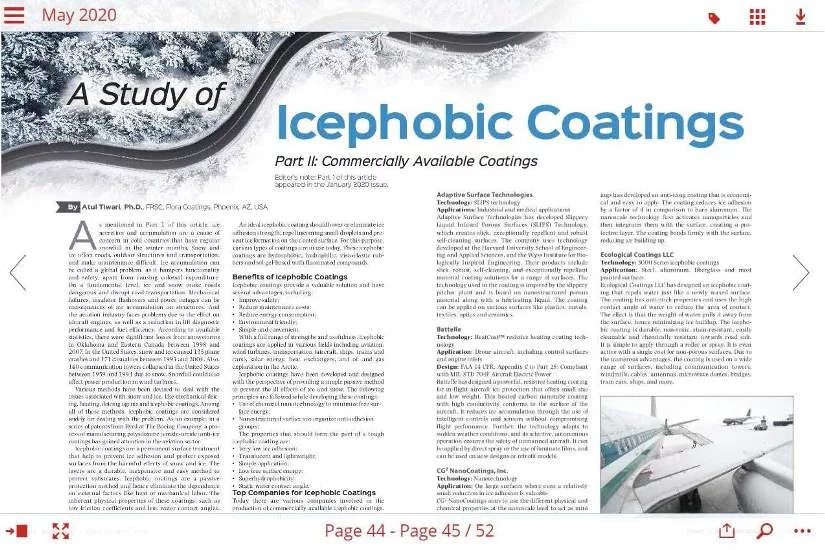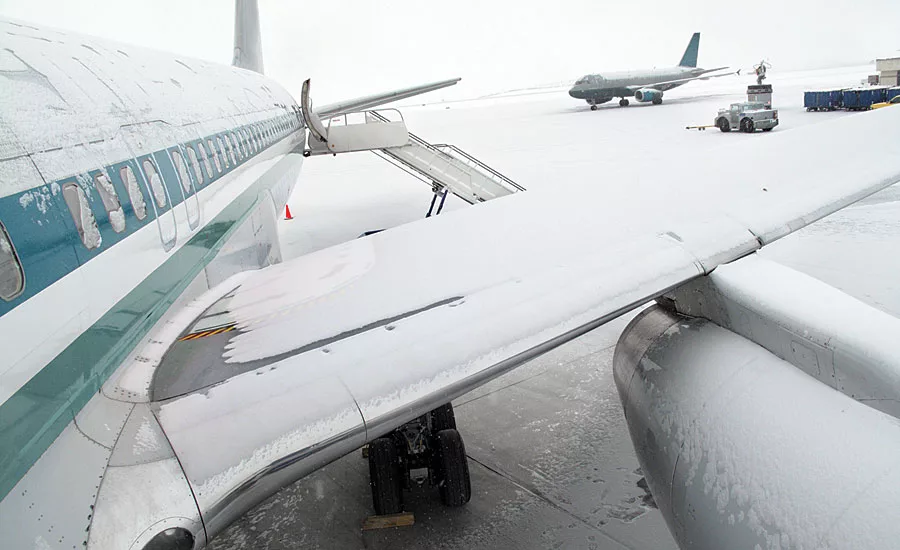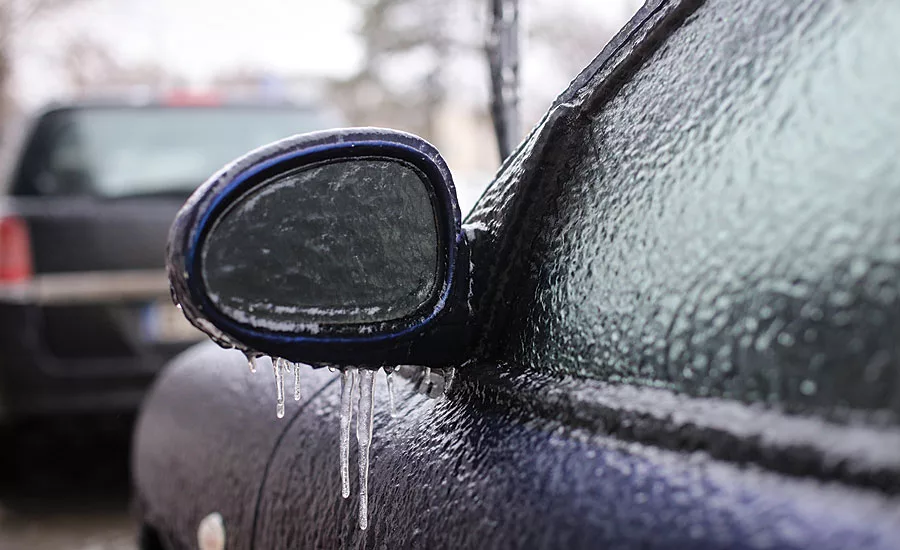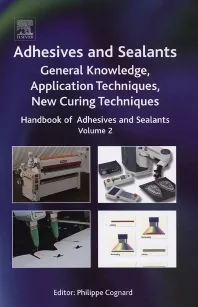A Study of Icephobic Coatings, Part 2
Editor’s note: Part 1 of this article appeared in the January 2020 issue.
As mentioned in Part 1 of this article, ice accretion and accumulation are a cause of concern in cold countries that have regular snowfall in the winter months. Snow and ice affect roads, outdoor structures and transportation, and make maintenance difficult. Ice accumulation can be called a global problem, as it hampers functionality and safety, apart from causing colossal expenditure. On a fundamental level, ice and snow make roads dangerous and disrupt road transportation. Mechanical failures, insulator flashovers and power outages can be consequences of ice accumulation on structures. And the aviation industry faces problems due to the effect on aircraft engines, as well as a reduction in lift diagnostic performance and fuel efficiency. According to available statistics, there were significant losses from snowstorms in Oklahoma and Eastern Canada between 1998 and 2007. In the United States, snow and ice caused 135 plane crashes and 171 casualties between 1993 and 2004. Also, 140 communication towers collapsed in the United States between 1959 and 1994 due to snow. Snowfall could also affect power production in wind turbines.
Various methods have been devised to deal with the issues associated with snow and ice, like mechanical deicing, heating, deicing agents and icephobic coatings. Among all of these methods, icephobic coatings are considered widely for dealing with the problem. As an example, in a series of patents from Byrd at The Boeing Company, a process of manufacturing polysiloxane (amide-ureide) anti-ice coatings has gained attention in the aviation sector.
Icephobic coatings are a permanent surface treatment that help to prevent ice adhesion and protect exposed surfaces from the harmful effects of snow and ice. The layers are a durable, inexpensive and easy method to protect substrates. Icephobic coatings are a passive protection method and hence eliminate the dependence on external factors like heat or mechanical labor. The inherent physical properties of these coatings, such as low friction coefficients and less water contact angles, help to repel ice from surfaces.
An ideal icephobic coating should lower or eliminate ice adhesion strength, repel incoming small droplets and prevent ice formation on the coated surface. For this purpose, various types of coatings are in use today. These icephobic coatings are hydrophobic, hydrophilic, viscoelastic rubbers and sol-gel-based with fluorinated compounds.
Benefits of Icephobic Coatings
Icephobic coatings provide a valuable solution and have several advantages, including:
- Improve safety;
- Reduce maintenance costs;
- Reduce energy consumption;
- Environment friendly;
- Simple and convenient.
With a full range of strengths and usefulness, icephobic coatings are applied in various fields including aviation, wind turbines, transportation (aircraft, ships, trains and cars), solar energy, heat exchangers, and oil and gas exploration in the Arctic.
Icephobic coatings have been developed and designed with the perspective of providing a simple passive method to prevent the ill effects of ice and snow. The following principles are followed while developing these coatings:
- Use of chemical nanotechnology to minimize free surface energy;
- Nanostructured surfaces to organize anti-adhesion groups;
The properties that should form the part of a tough icephobic coating are:
- Very low ice adhesion;
- Translucent and lightweight;
- Simple application;
- Low free surface energy;
- Superhydrophobicity;
- Static water contact angle.
Top Companies for Icephobic Coatings
Today there are various companies involved in the production of commercially available icephobic coatings. Here are some of the top companies in the field:
Adaptive Surface Technologies
Technology: SLIPS technology
Applications: Industrial and medical applications
Adaptive Surface Technologies has developed Slippery Liquid Infused Porous Surfaces (SLIPS) Technology, which creates slick, exceptionally repellent and robust self-cleaning surfaces. The company uses technology developed at the Harvard University School of Engineering and Applied Sciences, and the Wyss Institute for Biologically Inspired Engineering. Their products include slick, robust, self-cleaning, and exceptionally repellant material coating solutions for a range of surfaces. The technology used in the coating is inspired by the slippery pitcher plant and is based on nanostructured porous material along with a lubricating liquid. The coating can be applied on various surfaces like plastics, metals, textiles, optics and ceramics.
Battelle
Technology: HeatCoat™ resistive heating coating technology
Application: Drone aircraft, including control surfaces and engine inlets
Design: FAA 14 CFR, Appendix C to Part 25; Compliant with MIL-STD 704F Aircraft Electric Power
Battelle has designed a powerful, resistive heating coating for in-flight aircraft ice protection that offers small size and low weight. This heated carbon nanotube coating with high conductivity conforms to the surface of the aircraft. It reduces ice accumulation through the use of intelligent controls and sensors without compromising flight performance. Further, the technology adapts to sudden weather conditions, and its selective, autonomous operation ensures the safety of unmanned aircraft. It can be applied by direct spray or the use of laminate films, and can be used on new designs or retrofit models.
CG2 NanoCoatings, Inc.
Technology: Nanotechnology
Application: On large surfaces where even a relatively small reduction in ice adhesion is valuable
CG2 NanoCoatings aims to use the different physical and chemical properties at the nanoscale level to act as mini chemical reactors for protecting surfaces. CG2 NanoCoatings has developed an anti-icing coating that is economical and easy to apply. The coating reduces ice adhesion by a factor of 4 in comparison to bare aluminum. The nanoscale technology first activates nanoparticles and then integrates them with the surface, creating a protective layer. The coating bonds firmly with the surface, reducing ice building up.
Ecological Coatings LLC
Technology: 3000 Series icephobic coatings.
Application: Steel, aluminum, fiberglass and most painted surfaces
Ecological Coatings LLC has designed an icephobic coating that repels water just like a newly waxed surface. The coating has anti-stick properties and uses the high contact angle of water to reduce the area of contact. The effect is that the weight of water pulls it away from the surface, hence minimizing ice buildup. The icephobic coating is durable, non-toxic, stain-resistant, easily cleanable and chemically resistant towards road salt. It is simple to apply through a roller or spray. It is even active with a single coat for non-porous surfaces. Due to the numerous advantages, the coating is used on a wide range of surfaces, including communication towers, windmills, cables, antennas, microwave domes, bridges, train cars, ships, and more.
Equinor ASA (previously Statoil ASA)
Technology: Carbon nanotube technology
Application: Wind turbines, aviation, pavement, marine, arctic explorations, power transmission, etc.
Equinor ASA (previously Statoil ASA) is a Norwegian energy company that has developed a nanotechnology coating for anti-icing and de-icing surfaces. The company aims to provide a super-hydrophobic, self-cleaning, nano-structured coating. The technology focuses on ice nucleation, condensation, super-hydrophobicity, surface nanostructuring, and lowest possible ice-adhesion to surfaces. The research conducted studied in detail the correlation of the surface properties with icephobicity and various ice types. The result of the study was a slippery coating without the use of oils with extremely low ice adhesion.
FLORA Coatings
Technology: AVIRAL technology
Application: Military aerospace, wind turbines, bridges, railways, communication towers, etc.
Flora Coatings has developed a coating that provides significant icephobicity and hydrophobicity in very cold as well as humid climates. The coating inhibits ice nucleation through strong, water-repellent properties and high angles of water with the surface. The technology not only reduces ice nucleation but also protects against atmospheric corrosion in harsh weather conditions. The AVIRAL coating has been evaluated and reported by the U.S. Navy and U.S. Army as a part of the DTRA program.
Fraunhofer IFAM
Technology: Tailored coating systems for specific technical tasks
Application: Wind turbines, aircraft, etc.
Fraunhofer IFAM is a research institute in Europe that conducts continuous research on adhesive bonding technology, surfaces, shaping and functional materials. Chemists, coating technologists, biologists and technicians work closely with industry and other R&D partners to develop customized and effective anti-icing solutions. The institute has developed hydrophobic coatings and heatable coatings, and uses techniques like incorporating freezing point depressors into coatings and using peptides from anti-freeze proteins. It has developed its own ice chambers to conduct tests.
Fraunhofer IGB
Technology: Nano and micro-structured coatings by means of plasma technology
Application: Aircraft wings, wind turbines, solar panels, building parts, power lines, textiles, sports equipment, refrigerators
Fraunhofer IGB is an institute focused on research and its implementation. The organization has developed various anti-ice coatings that can be used to reduce the large-scale icing of surfaces. In the “Nanodyn” joint project funded by the Federal Ministry of Education and Research, Fraunhofer IGB developed water-repellent micro- and nanostructured layers, on which water remains liquid even at temperatures below zero degrees. As a result, ice formation is largely prevented. Even when the water freezes, the anti-ice technology reduces the adhesion of ice by more than 90 percent compared to uncoated surfaces. The group is also working to attach structured anti-ice coatings on self-adhesive plastic foils by means of plasma technology, creating an anti-ice film that can laminate components.
GE Global Research
Technology: “Nano-textured,” super-hydrophobic coatings
Application: Jet engines, wind turbines, etc.
GE Global Research has formulated icephobic coatings using nanoparticles for super-hydrophobic surfaces. These “nano-textured,” super-hydrophobic coatings are extremely water-repellant and prevent ice formation as well as ice adhesion to surfaces. The technology also delays the freezing of water up to 80 seconds in comparison to non-coated surfaces. That delay could mean big efficiency gains and cost savings for operators of machines susceptible to ice buildup.
HygraTek LLC
Technology: Ice delamination propagation coating
Application: Aerospace, naval applications, etc.
HygraTek LLC offers coating technology that has extremely low ice adhesion values of less than 5kPa. The sprayable coating is transparent, easily applicable and bondable with a wide range of surfaces like glass, polymers, metals, ceramics, etc. Scientific studies are conducted to analyze the adhesion of ice to various surfaces to develop an icephobic coating with the lowest possible ice adhesion value.
KISS Polymers LLC
Technology: KISS-COTE® Technology or self-bonding polymers
Application: Aviation, marine, etc.
KISS Polymers LLC has developed smooth, water-proof, non-toxic, non-stick icephobic coatings for a range of surfaces. The coat is one-molecule thick and is slippery yet dry, where water will bead and runoff. Also, the coating can be applied to steel, aluminum, plastics, marble, tiles, resins, and natural and synthetic fibers. The coating is easy to apply as a spray or dab as a gel at room temperature. Due to the ability of the coating to endure extremely cold temperatures, it is used in aerospace by NASA.
Luna Innovations
Technology: Gentoo hydrophobic icephobic coating technology
Application: Aerospace, space, marine, oil pumping and drilling, and special chemical processing
Luna has developed an array of durable, easily applied hydrophobic coatings that repel water from metal surfaces. These hydrophobic coatings have demonstrated effectiveness for rain repellency and erosion on a number of transparent substrates. This coating sheds water efficiently while being highly abrasion resistant. The company’s scientists have also developed modified formulations for preventing and/or shedding ice (anti-icing). Through their licensing partner UltraTech International, Luna has been marketing their product Gentoo for hydrophobic and icephobic applications. Gentoo is a combination of silane-modified urethane crosslinked with tetraethoxy silane and possible metal catalyst in alcohol solvent.
Nanohmics
Technology: Nanoimprint lithography for a super-hydrophobic surfaces
Application: Commercial aircraft, marine, etc.
Nanohmics has developed a tape that can be imprinted with a superhydrophobic surface. The material can work alone or with an active deicing/anti-icing technology for increased effectiveness. The company uses nanoimprint lithography to etch a superhydrophobic surface topography into the surface of a hard coating material. Using proprietary deposition methods, depositing the hard coating onto flexible substrates in the form of a robust superhydrophobic adhesive tape allows the material to be directly applied to surfaces requiring ice protection.
NanoSonic, Inc.
Technology: HybridShield nanocomposite technology
Application: Ships, automotive, highway barriers, multi-surface
NanoSonic Inc. offers an easily applicable anti-icing coating in an aerosol spray cans that are suitable for numerous types of surfaces. The coating is durable and exhibits extremely low ice adhesion along with accretion temperature reductions. The coating technology uses a two-part fluidic resin and improved environmental durability. It exhibits a combination of icephobicity, ecological resistance and protection from corrosion, too, at an economical rate. The USA Navy has widely used this product.
Nanovere Technologies LLC
Technology: Nano-Clear® 3D nanostructured coating
Application: Polycarbonate, non-visual glass, granite and stone
Nanovere Technologies LLC’s Nano-Clear VV-300 coating provides a permanent covalent bond to new polycarbonate, non-visual glass, granite and stone. This high-gloss, multi-functional coating improves optical clarity and provides remarkable scratch resistance, water, dirt and ice repellency, chemical resistance, UV and heat resistance. The coating penetrates deep into the small pores of painted or oxidized surfaces and forms a highly crosslink dense/hard coat surface. The company uses proprietary 3D nanostructured polymers.
NBD Nano
Technology: RepelShell® coating
Application: Glass and metal
NBD Nano has developed a variety of hydrophobic coatings that create ultra-repellent surfaces. The coatings provide exceptional surface repellency and durability and offer minimum ice adhesion due to crosslink density.
NEI Corporation
Technology: NANOMYTE® SuperAi and SuperAi-UVP coating technology
Application: Wind turbines, overhead high voltage power lines, transportation, marine, and others
NEI Corporation’s NANOMYTE coating imparts anti-icing properties to the underlying substrate, reducing ice adhesion by up to 80%. The nanocomposite coating is hard and transparent, providing a smooth and glossy finish with low haze. The single-component coating can be applied by brush, spray or wipe, with no primer or curing required. The technology was focused on the development of a surface that can endure repeated deicing.
Opus Materials Technology
Technology: Icemart coating technology
Application: Aviation industry
Opus Materials Technology has developed a passive ice-repellant coating that inhibits the formation and accumulation of ice on surfaces. The layer uses nanotechnology along with new additives to enhance the protective quality of the surface. The technology offers a complete anti-icing, de-icing and ice-resistant coating that is long-lasting, self-cleaning and shiny.
X-Therma Inc.
Technology: XT-Vivo™ cryoprotectants and cryopreservants
Application: Medical field
X-Therma focuses on implementing the latest scientific breakthrough technology in the medical field. The company uses nanoscience to create new molecules, and uses both nanoscience along with cryobiology. The company aims to provide effective, safe, and long term bio-storage of transplantable organs, stem cells and regenerative medicines. The technology is a non-toxic, hyper-effective, chemically defined, and ideally stable solution for long term bio-banking and safer transportation. The company’s XT-Vivo™ product is developed as a DMSO-free, serum-free, protein-free, state-of-the-art ice-blocking preservation solution.
Challenges Facing Icephobic Coatings
Icephobic coating manufacturers face some challenges. These problems include:
- Mechanical strength;
- Chemical durability;
- Difficult to repair;
- Applicability of all types on all surfaces;
- Performance in high humidity conditions.
Conclusion
There is a steady rise in the demand and need for icephobic coatings as a passive way to deal with the problems related to snow, ice and extreme weather conditions. The reason for the rising popularity is the high energy consumption by de-icing devices as well as high costs included in maintenance. Further, the effect of de-icing salts and chemicals on the environment is being studied widely. The long-term effects of these chemicals on the soil, lakes, streams, water tables and wastewater are being taken into consideration to develop better icephobic coatings. Extensive research is being conducted by companies and institutes jointly and separately to design better, environment-friendly industrial coatings for this type of environment.
References
1. Norman R. Byrd, Polysiloxane (amide-ureide) anti-ice coating, US Patent 6,797,795 B2.
2. Norman R. Byrd, Dougulas G. Soden, Composition and method for corrosion protection of a structure, US Patent 8,367,791 B2.
3. https://en.wikipedia.org/wiki/Icephobicity
4. https://www.researchandmarkets.com/reports/4401802/the-global-market-for-anti-icing-and-de-icing
5. https://www.battelle.org/government-offerings/national-security/payloads-platforms-controls/deicing-technology
6. https://www.cg2nanocoatings.com/antiice.shtml
7. http://www.ecologicalcoatings.com/icephobic.html
8. https://www.ifam.fraunhofer.de/en/Profile/Locations/Bremen/Adhesive_Bonding_Surfaces/Paint_Lacquer_Technology/Functional_Paints_Coatings/Anti-icing_Coatings.html
9. https://www.ge.com/reports/post/74545035920/breaking-the-ice-ge-global-research-scientists/
10. https://www.kisspolymers.com/Products/products.htm
11. https://www.sbir.gov/sbirsearch/detail/1604131
12. https://lunainc.com/applied-research/applied-research-technologies/materials/protective-coatings-surface-treatments/
13. https://www.bsee.gov/sites/bsee.gov/files/tap-technical-assessment-program/597ab.pdf
14. https://nanosonic.com/product/hybridshield-icephobic/
15. http://www.nanocoatings.com/VV300.pdf
16. https://www.nbdnano.com/solutions/coatings/
17. https://floracoating.com/our-products/barrier-coatings/
18. https://www.neicorporation.com/anti-ice-for-aerospace-case-study/
19. https://wyss.harvard.edu/media-post/slips-keeping-ice-away/
20. https://www.ntnu.edu/documents/1283057195/1283619985/NML+2019-anti-icing.pdf/bb0f332d-9058-4a18-82ee-815ef627f5f0
21. https://x-therma.com/
Disclaimer: This article is written to educate or inform readers about the anti-icing or icephobic products available in the market. No attempt has been made to endorse any product or create a comparison or superiority of a product over another. The text written here is a view of the author and has nothing to do with the company Flora Coatings. Information shown here is the best to the author's knowledge and does not claim complete accuracy.
Looking for a reprint of this article?
From high-res PDFs to custom plaques, order your copy today!












